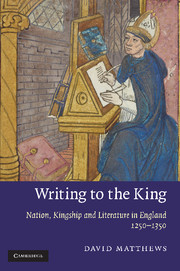Book contents
- Frontmatter
- Contents
- Preface
- Abbreviations
- Introduction
- 1 Defending Anglia
- 2 Attacking Scotland: Edward I and the 1290s
- 3 Regime change
- 4 The destruction of England: crisis and complaint, c.1300–41
- 5 Love letters to Edward III
- Envoy
- Appendix: The tail-rhyme poems of Langtoft's chronicle
- Notes
- Bibliography
- Index
- CAMBRIDGE STUDIES IN MEDIEVAL LITERATURE
Introduction
Published online by Cambridge University Press: 07 May 2010
- Frontmatter
- Contents
- Preface
- Abbreviations
- Introduction
- 1 Defending Anglia
- 2 Attacking Scotland: Edward I and the 1290s
- 3 Regime change
- 4 The destruction of England: crisis and complaint, c.1300–41
- 5 Love letters to Edward III
- Envoy
- Appendix: The tail-rhyme poems of Langtoft's chronicle
- Notes
- Bibliography
- Index
- CAMBRIDGE STUDIES IN MEDIEVAL LITERATURE
Summary
THE KNIGHT OF THE LETTER: WRITING TO THE KING
As King Edward II celebrated the feast of Pentecost in 1317 in Westminster Hall with his magnates, a surprising visitor arrived:
A certain woman, dressed and equipped in the guise of an entertainer, mounted on a good horse bearing an entertainer's medallions, entered the said hall, circulated amongst the tables in the mode of an entertainer, ascended to the dais by the step, boldly approached the royal table, laid down a certain letter before the king, and, hauling on the bridle, having greeted the guests, without commotion or hindrance departed on the horse.
At which the great as well as the less, looking by turns at one another, and judging themselves to be scorned by such a deed of daring and female mockery, sharply rebuked the doorkeepers and stewards concerning that entry and exit. But they, thrown into perplexity, made a virtue of necessity, saying that it was not the practice of the king to deny access, on such a solemn feast–day, to any minstrel wishing to enter the palace.
At length the woman is sought out, captured, and put in prison; asked why she had acted thus, she boldly confessed that she had been instructed to do this by a certain knight, and had been hired for money.
The knight is taken and is brought before the King, summoned concerning the one sent before.
Information
- Type
- Chapter
- Information
- Writing to the KingNation, Kingship and Literature in England, 1250–1350, pp. 1 - 28Publisher: Cambridge University PressPrint publication year: 2010
